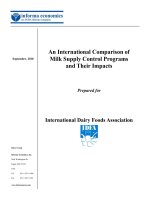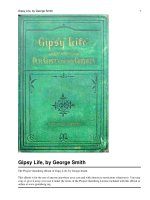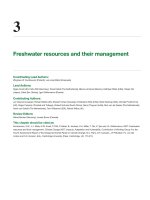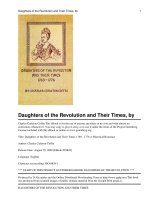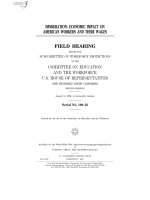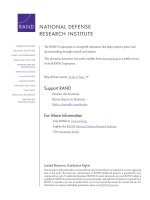Knitted fabric faults and their remedies
Bạn đang xem bản rút gọn của tài liệu. Xem và tải ngay bản đầy đủ của tài liệu tại đây (2.34 MB, 50 trang )
Total Texle Process at a Glance
PROJECT
ON
Root Causes Analysis of knitted
Fabric Faults & Their Remedies
3
3
Content
Introduction
Causes of Fabric faults due to yarn
Causes of Fabric faults due to knitting
Causes of Fabric faults due to Dyeing &
Finishing
Conclusion
4
4
Introduction
Due to increasing the demand for quality knitted fabrics,
high quality requirements are today greater since customer
has become more aware of “Non-quality" problems, in
order to avoid fabric rejection, knitting mills have to
produce fabrics of high quality, constantly. Detection of
faults during production of knitted fabric with circular
knitting machine is crucial for improved quality and
productivity. Any variation to the knitting process need to
be investigated and corrected. The high quality standard
can be guaran teed incorporating appropriate quality
assurance. Industrial analysis indicate that quality can be
improved, and defect cost minimized, by monitoring of the
circular knitting process.
5
5
Our aim of this project is to study on root causes analysis of
knitted fabric faults. To do so we have collected various
type of faults from many industries and classify them in a
systematic manner
6
6
Causes of Fabric faults due to Yarn
Almost all the defects appearing in the horizontal direction,
in the knitted fabric are, yarn related.
These defects are mainly:
I) Barriness
II) Spirality
III) Shrinkage
IV) Thick & thin place
7
7
I). BARRINESS
Definition:
Barriness defect appears in
the Knitted fabric, in the
form of horizontal stripes
of uniform or variable
width.
8
8
Fig:Barriness
Causes Of Barriness:
factors which may cause or contribute to barre are listed as
follows:
Raw material/fiber
Yarn formation /supply
Knitting machine
9
Raw Material/Fiber:
Failure to control fiber diameter
(micronaire or denier) from lay down to
lay down.
Too high a C.V. of micronaire in the lay
down for a given mill's opening line
blending efficiency.
Failure to control the fiber color in the mix
(grayness Rd, yellowness +b).
10
Yarn Formation/Supply:
Poor blending of fiber in opening through finisher drawing.
Mixing yarns of different counts.
Mixing yarns from different spinning systems.
Mixing yarns with different twist level/twist direction.
Mixing yarns with different degrees of hairiness.
Mixing yarns with different amounts of wax.
Excessive back winding or abrasion during this process.
11
Knitting Machine:
Improper stitch length at a feed.
Improper tension at a feed.
Variation in fabric take-up from loose to tight.
Excessive lint build-up.
Variation in oil content.
Worn needles, which generally produce length direction
streaks.
Uneven cylinder height needles (wavy barre).
Double feed end.
12
Remedies
Remedies
:
:
Ensure uniform Yarn Tension on all the
feeders.
The average Count variation in the lot, should
not be more than + 0.3
Ensure that the yarn being used for Knitting is
of the same Lot / Merge no.
Ensure that the hardness of, all the yarn
packages, is uniform, using a hardness tester.
13
II).SPIRALITY
Definition:
Spirality appears in the
form of a twisted garment,
after washing. The seams
on both the sides of the
garment displace, from
their position & appear on
the front & back of the
garment.
14
Fig:Spiraility
Influencing Factors:
A) Influence of yarn properties
Count
Twist
Blend
B) Influence of fabric properties:
Fabric Stitch length:
Fabric Structure
Fabric Tightness
15
(III). SHRINKAGE
A dimensional change resulting in a decrease in the length
or width of a specimen subjected to specified conditions is
known shrinkage. Shrinkage is mainly due to yarn swelling
and the resulting crimp increase during washing in case of
cotton fabrics
16
Causes of Shrinkage:
Twi
s
st factor: twist factor increases so that
shrinkage will be increases,
Stitch length: stitch length increases so that
shrinkage will be increases,
GSM: GSM increases so that shrinkage will be
increases
17
Remedies of Shrinkage
Keep the Grey Fabric in loose plated form, immediately
after the roll is cut.
Store the finished fabric also in the plated form & not in
the roll form.
Allow the fabric to relax properly, before it is cut.
Give maximum overfeed to the fabric, during the
processing, on the Stenter, Compactor & the Calendaring
machines.
18
(IV) Thick & Thin Places
It causes due to yarn
problem. If thick & thin
places remain in yam &
fabric is knitted with
that yarn, then, this
problem found in fabric.
Fig: Thick Thin Place
19
Causes of Fabric faults due to Knitting
Almost all the defects appearing in the vertical direction,
in the knitted fabrics, are as a cause of bad Knitting
Elements. And some defects appear randomly in the
knitted fabrics, due to the wrong knitting machine settings
& that of the machine parts
About Different type of faults are discuses bellow
21
Cracks Or Holes
Local holes obtained when yarn breaks during
loop formation.
Causes
Presence of knot in yarn.
Weak places in yarn.
Yarn tension too high.
Yarn too dry.
Yarn - guide not properly
set,
Poorly lubricated yarn.
Fig:Hole
22
Remedies:
Use of flat knots.
Yarn regularity control.
Yarn consumption & coulier re-adjustment.
Precise yarn - guide resetting.
Air humidification.
guide blowing.
Use of protective filter creel.
23
Pin Hole
Causes:
Improper tension.
Same drive for both knit & tuck stitch.
Curved needle latch.
Remedies:
Different drive have to maintained
Needle has to change.
Needle has no change.
Fig:PinHole
24
Fly Contaminations
Causes:
Presence of dead fibers & other foreign materials, such as;
dyed fibers, husk & synthetic fibers etc.
Dead fibers do not pick up color during Dyeing.
25
Fig:Flycontamination
Remedies
Use rich fiber mixing for the yarns, to be used for Knitting,
in order to have less dead fibers, appearing in the fabric.
Rigid control measures in the Blow Room, to prevent the
mixing of foreign matters in the Cotton mixing
26

